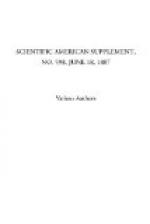Canvas and woven fabrics, coated with India-rubber, are also now being used for driving belts and for covering machine rollers. As this material can be made in one piece, without the necessity of a joint, it is uniform in strength, and is recommended as a substitute for leather belts requiring joints. A patented material of this description is due to Zingler, who boils the canvas or similar woven fabric under pressure in a solution of tungstate of soda for three hours. It is then transferred to a bath of acetate of lead solution, and drained, dried, and stretched. When in this condition it is coated, by means of a spreading machine, with repeated layers of a composition consisting of India-rubber, antimony sulphide, peroxide of iron, sulphur, lime, asbestos, chalk, sulphate of zinc, and carbonate of magnesia. When a sufficient thickness of this composition has been applied, it is vulcanized under pressure at a temperature of 250 deg. F., or a little higher. The material produced in this manner is said to have the strength and durability of the best leather belts. Attempts have recently been made to obtain a glue suitable for joining the ends of driving belts, without the use of metal fastenings or sewing, and Messrs. David Kirkaldy & Son have reported favorably on such a belt glue, which is being introduced by Mr. W.V. Van Wyk, of 30 and 31 Newgate street, E.C. In the test applied by them, a joint of this “Hercules glue,” as it is called, in a 4 in. single belt was stronger than the solid leather. When a tensile stress of 2,174 lb., equivalent to 2,860 lb. per square inch of section, was applied, the leather gave way, leaving the joint intact. Belts fastened by a scarf joint with this glue are said to be of absolutely the same thickness and pliability at the joint as in the main portion of the belt, and thus insure freedom from noise and perfect steadiness. The instructions for use are simple, and it requires only fifteen minutes for the joint to set before being ready for use. From a rough chemical analysis of the sample submitted to us, we find that it consists of gelatine, with small amounts of mineral ingredients. Josef Horadam, some few years ago, patented in Germany a process for preserving glues from decomposition, by the addition of from 8 to 10 per cent. of magnesium or calcium chlorides. The addition of these salts does not impair in any way the strength of the glue, but prevents it from decomposing, and it may be that the “Hercules glue” is preserved in a similar manner.




